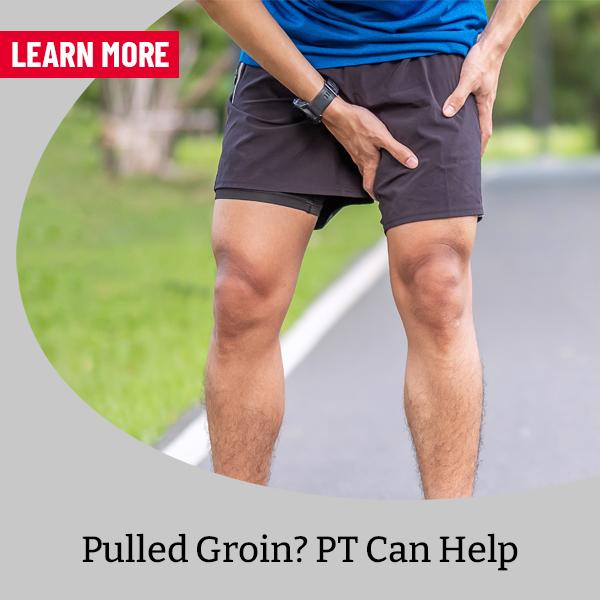
Athletes frequently suffer from groin strain or a torn ligament in the groin area. These muscle strains often occur during physical activity that includes the following:
- Quick starts and stops, especially in the lower body
- Sudden trauma (i.e. tackled on the field)
- Repetitive stress and overuse
Sports like basketball, soccer, ice hockey, distance running, football, and rugby are commonly associated with strain injury. According to research published in Orthopaedic Journal of Sports Medicine, “Among all sports, an adductor/groin tear was the most common injury reported, comprising 24.5% of all hip injuries.”1
How Long Can a Pulled Groin Muscle Last?
Marcus Ohnemus, Sports Medicine Supervisor with ATI Physical Therapy, discusses this injury, and what to do for a pulled groin muscle so that athletes with symptoms of a groin strain can get back in the game.
“Groin injuries can be very complicated, and unfortunately, difficult to recover from. Normal recovery time can be anytime from 4 to 12 weeks, depending on severity and the specific muscles involved."
Get Your Free Physical Therapy Screening
Learn how physical therapy can prove to be an effective treatment for groin injury. Get a free screening and let us help you start the path to recovery today.
GET MY COMPLIMENTARY SCREENING
What is a Groin Muscle?
The groin muscles are located where the abdomen meets the leg, and the muscles of the inner thigh are attached to the front of the hip. A torn groin injury occurs when these adductor muscles are overstretched because of extreme force.
The groin muscles are complex and include six different muscles. Groin muscles help with movements of the hip joint. In fact, groin injuries are often misdiagnosed as hip injuries leading to continued pain and tenderness.
Symptoms of a Pulled Groin
Individuals suffering from pain in the groin area often display or describe the following:
- Hearing a “pop” in the groin following time of injury
- Sharp pain
- Swelling
- Bruising
- Tightness
- Leg weakness
- Limping
Individuals with a torn groin injury may feel pain in other areas of the body, including the hip, pelvis, and lower back.
Torn Groin Injury Diagnosis
To diagnose a torn groin injury, doctors will conduct a physical examination or provide a referral to a specialist, like a sports medicine professional. This physician team may request an X-ray or MRI to assist with diagnosis.
Levels of Torn Groin Injuries
Torn groin injuries are given a grade, according to the amount of damage:
Grade 1: Mild overstretching or slight tearing of muscle fibers. The muscle is painful, but has near normal strength.
Grade 2: Moderate tear of a larger amount of muscle fibers. More tenderness and pain than Grade 1, loss of strength and sometimes bruising.
Grade 3: Tear of muscle is severe, and can be a complete muscle tear. Bruising is present.
Pulled Groin Injury Recovery Time
Torn or pulled groin recovery time can vary based on the severity of the injury. The complexity of the injury and the individuals' strength prior to injury can impact the torn or pulled groin recovery time period. Typically, pulled groin recovery time can run between 4-12 weeks and estimates for each grade are below:
- Grade 1: 4-6 weeks
- Grade 2: 2-3 months
- Grade 3: 4+ months
Initial Phase: When muscle fibers are torn, they heal with a complicated matrix of tissue within the muscle called scar tissue. During this initial phase of healing, which runs 7 to 10 days, you must allow for this scar tissue formation while working on gentle range of motion without stressing the muscle.
Secondary Phase: After the healing process, the second phase of rehabilitation begins. Weeks 1 to 3 involve strength training for the groin muscles and all the muscles surrounding the hip and abdomen.
Final Phase: Once adequate strength is achieved in the injured muscle, functional rehabilitation begins. You work on sport specific skills and change of direction activities. This will take place at weeks 3 to 6. For professional athletes, this means returning to the types and levels of activity typical in their sport.
How to Heal a Pulles Groin Injury
Torn groin injuries can heal on their own given time and rest. To assist with treatment treatment for groin injury and pain management, try:
- Ice: Ice the inside of the thigh. This will reduce pain and swelling, which can speed up recovery.
- Compression: Use an elastic bandage or tape to compress the thigh.
- Painkillers: Take nonsteroidal anti-inflammatory drugs (NSAIDs), like ibuprofen, to help with pain and swelling.
Groin Injury Physical Therapy
In addition, physical therapy exercises that stretch and strengthen adductor muscles can be used even after recovery to prevent reinjury. Groin physical therapy will help torn groin recovery by reducing pain, returning full motion in the leg, hip and thigh, and ultimately improving strength by utilizing appropriate exercises assigned by a physical therapist.
Groin Tear Surgery
Surgery can be needed to repair a torn groin, but this is a rare occurrence.
Physical Therapy for a Groin Injury at ATI
If you are experiencing torn groin symptoms, schedule an appointment online for a free consultation at any ATI Physical Therapy location. ATI can evaluate your injury and provide you with options for continued care. You'll be seen by a licensed provider who will provide appropriate recommendations.
1. Kerbel, Y. E., Smith, C. M., Prodromo, J. P., Nzeogu, M. I., & Mulcahey, M. K. (2018). Epidemiology of Hip and Groin Injuries in Collegiate Athletes in the United States. Orthopaedic Journal of Sports Medicine. https://doi.org/10.1177/2325967118771676
